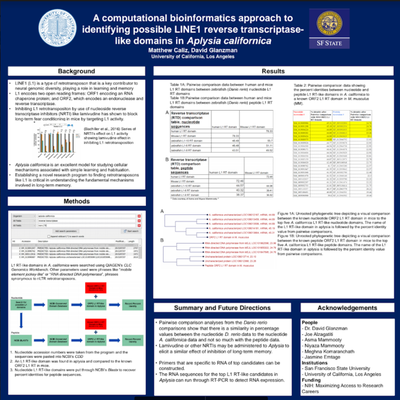
Matthew Caliz
Home Institution: San Fracisco State University
UCLA Mentor: Dr. David Glanzman
Program: BRI-SURE
Abstract:
Recent research uncovered LINE1 (Long-Interspersed Nuclear Elements) or L1’s, a group of retrotransposons, as a key contributor to neural genome diversity, and playing a role in learning and memory. L1 is a class I retrotransposon that encodes two open reading frames: ORF1 encoding a RNA chaperone protein; and ORF2, which encodes an endonuclease and reverse transcriptase. Further, inhibiting L1 retrotransposition in mice blocked long-term fear conditioning memories via the use of lamivudine, a common nucleoside reverse transcriptase inhibitor that also inhibits L1 activity. Determining the presence of L1 transposable elements in other organisms presents a novel research program in understanding the fundamental mechanisms involved in long-term memory. L1 reverse transcriptase (RT)-like domains were located in the sea slug Aplysia californica using the NCBI Conserved Domains Database and NCBI Blastx programs. Pairwise comparisons were performed between the nucleotide and peptide sequences of a known ORF2 L1 RT element in Mus musculus and uncharacterized L1 RT-like domains in A. californica. Pairwise comparison data showed percent identities in nucleotide L1 RT-like domains to be higher than 40% and peptide comparison values higher than 20%. These analyses may support the claim that L1 RT-like domains in A. californica can be manipulated by lamivudine and other reverse transcriptase drugs to elucidate the contribution of L1 retrotransposition to the expression of memory.

